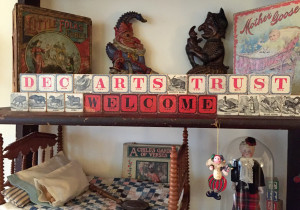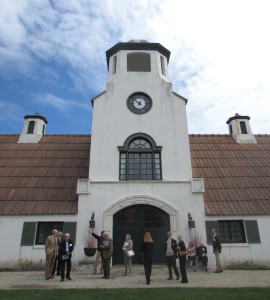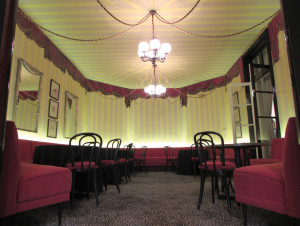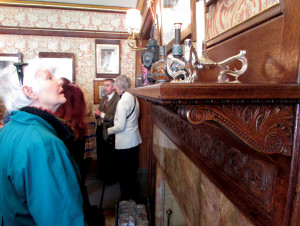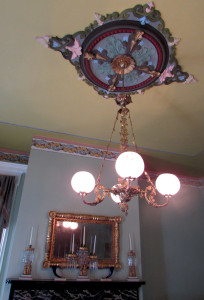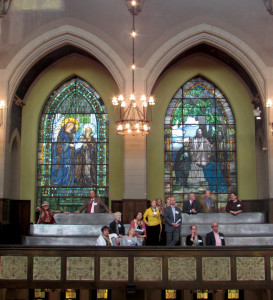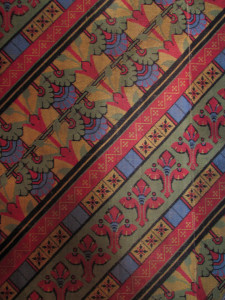Windy City Blows Spring Symposium Attendees Away
EVENTS > SYMPOSIA > Windy City Blows Spring Symposium Attendees Away
REVIEW: TRUST’S 2015 SPRING SYMPOSIUM
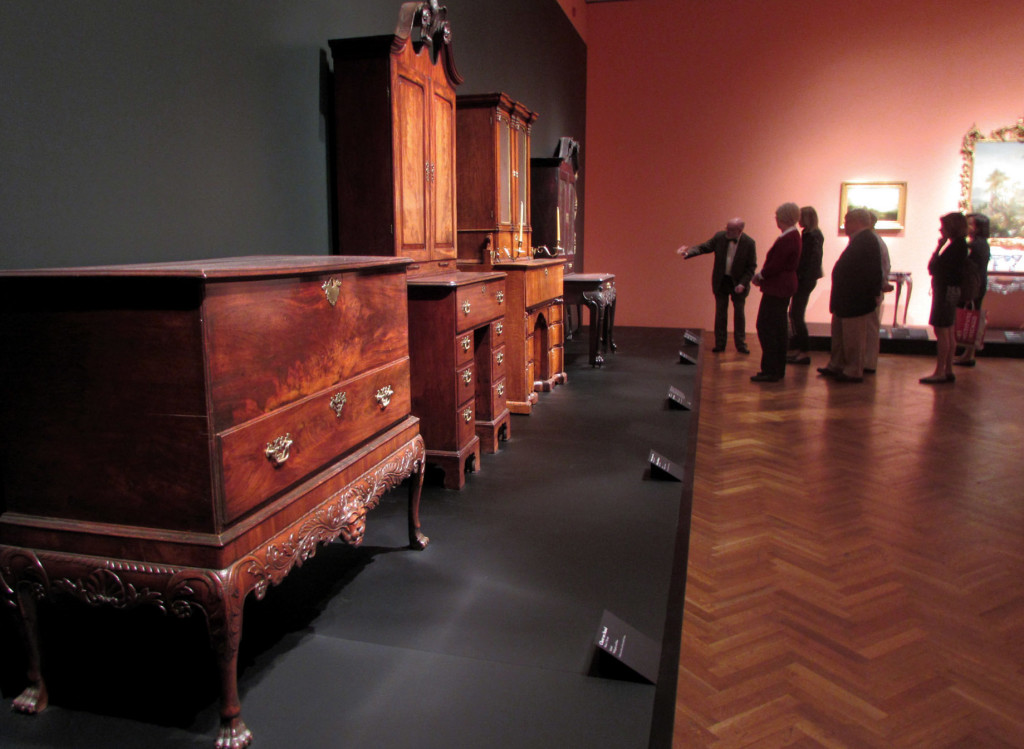
Christopher Monkhouse describes the carving on a remarkable lineup of Irish case pieces.
While Christopher Monkhouse’s splendid exhibition on Irish decorative and fine arts provided the impetus for the Trust’s 2015 spring symposium in Chicago, the city’s extraordinary breadth and depth of cultural and architectural riches left an indelible impression on the sold-out crowd.
The Irish show did not disappoint (see review). Beautifully installed with exceptional objects, the experience was brought to further heights by Mr. Monkhouse and his talented research associate, Leslie Fitzpatrick, as tour guides extraordinaire. Their insight into the remarkable items assembled at the Art Institute of Chicago assured the Trust’s appreciation for the talents and accomplishments of Ireland’s artisans and artists.
The curators’ decision to limit the loan list to objects in North American collections testified to the diaspora of Ireland’s material culture in the 19th and 20th centuries during periods of famine, poverty, and warfare. We were grateful for the opportunity to bask in the show’s glory for a few brief hours and collectively lamented the realization that Chicago was the sole venue for such a remarkable achievement of curatorial practice.
Not to be outdone, our hosts in the AIC’s American arts department provided fantastic tours of their galleries. Annelise Madsen introduced participants to the museum’s extraordinary collection of 19th-century paintings, paying particular attention to Winslow Homer’s The Herring Net.
Monica Obniski, who recently left the AIC to join the curatorial staff at the Milwaukee Art Museum, shared highlights of the AIC’s holdings in the Aesthetic and Arts and Crafts movements, including exceptional Chicago-made objects such as a fireplace surround by Louis Millet after a design by George Washington Maher. Her successor, Elizabeth McGoey, presented pre-1850 decorative arts, no small task given the strong representative collection that the AIC has developed over many decades of sage acquisitions and gifts.
Three Chicago clubs hosted the Trust for programs, and these venues offered an introduction the revival style architecture and interiors prevalent there in the late-19th and early-20th centuries. The University Club’s gothic and Fortnightly’s Georgian revival designs demonstrate the talents of their well-known architects Holabird & Roche and Charles F. McKim, respectively. The University Club, considered the country’s first “gothic skyscraper”, was one of the most expensive club buildings of its day, and our lecture hall featured an exquisite painted ceiling by Chicago artist Frederic Clay Bartlett. The Fortnightly began life as the Helen and Bryan Lathrop House, and McKim’s work for the Lathrops led to his selection as architect of the Agricultural Building at Chicago’s 1893 World’s Columbian Exposition.
Rue Winterbotham Carpenter’s Regency revival rooms at the Casino, however, were the real show stoppers. Drawing inspiration from French Napoleonic designs, Carpenter created stunning yet playful interiors that remain in a remarkable state of preservation. While not as renowned as her contemporary Elsie de Wolfe, Winterbotham’s ability to harness color, shape and form made her a highly sought-after decorator, and her talent and creativity remain on brilliant display at the Casino.
The Trust’s foray into the South Loop introduced participants to Chicago’s best-preserved turn-of-the-20th-century gems, Glessner House and Second Presbyterian Church, as well as the city’s oldest extant dwelling, the Clarke House of 1836. The first stands as a lasting and powerful testament to the architectural genius of Henry Hobson Richardson and retains an astounding percentage of Frances and John Glessner’s original furnishings. Glessner House’s director, Bill Tyre, ably assisted by architectural historian John Waters, underscored the depth of the Glessner’s involvement in the interior design and decoration, including cabinet work commissioned from Isaac Scott, a talented Philadelphia-trained furniture maker and carver, as well as A.H. Davenort and Herter Brothers, not to mention textiles, carpets, and wallpapers designed by William Morris & Co.
Second Presbyterian was a revelation for many, including those who typically dislike ecclesiastical sites or claim disinterest in Arts and Crafts design. Architectural historian Rolf Achilles and Friends of Historic Second Church’s president, Linda Miller, offered first-rate commentary. On the laundry list of attributes worthy of attention were stained glass windows by Tiffany Studios, Edward Burne-Jones for William Morris & Co, and the Church Glass and Decorating Company (see article from the Trust’s Fall 2014 magazine); painted decoration by the aforementioned Frederic Clay Bartlett; and its remarkable Brussels-weave carpet purchased from Marshall Field & Co. in 1901 and likely from a Morris design.
We strongly encourage Trust members who were unable to participate in the Chicago program to seek out another opportunity to visit in the near future. The city has so much to offer, and we merely scratched the surface!
SAVE THE DATE
- Special Symposium
“Classical Splendor”
The Philadelphia Museum of Art
November 4, 2016 - New York Antiques Weekend
January 20-21, 2017 - Spring Symposium
Savannah
April 21-24, 2017 - Spring Study Trip Abroad
Scotland
May 14-22, 2017 - Fall Symposium
Hartford & Western Connecticut
September 2017 - Fall Study Trip Abroad
Venice and the Veneto
October 9-16 and 22-29, 2017
While Christopher Monkhouse’s splendid exhibition on Irish decorative and fine arts provided the impetus for the Trust’s 2015 spring symposium in Chicago, the city’s extraordinary breadth and depth of cultural and architectural riches left an indelible impression on the sold-out crowd.
The Irish show did not disappoint (see review). Beautifully installed with exceptional objects, the experience was brought to further heights by Mr. Monkhouse and his talented research associate, Leslie Fitzpatrick, as tour guides extraordinaire. Their insight into the remarkable items assembled at the Art Institute of Chicago assured the Trust’s appreciation for the talents and accomplishments of Ireland’s artisans and artists.
The curators’ decision to limit the loan list to objects in North American collections testified to the diaspora of Ireland’s material culture in the 19th and 20th centuries during periods of famine, poverty, and warfare. We were grateful for the opportunity to bask in the show’s glory for a few brief hours and collectively lamented the realization that Chicago was the sole venue for such a remarkable achievement of curatorial practice.
Not to be outdone, our hosts in the AIC’s American arts department provided fantastic tours of their galleries. Annelise Madsen introduced participants to the museum’s extraordinary collection of 19th-century paintings, paying particular attention to Winslow Homer’s The Herring Net.
Monica Obniski, who recently left the AIC to join the curatorial staff at the Milwaukee Art Museum, shared highlights of the AIC’s holdings in the Aesthetic and Arts and Crafts movements, including exceptional Chicago-made objects such as a fireplace surround by Louis Millet after a design by George Washington Maher. Her successor, Elizabeth McGoey, presented pre-1850 decorative arts, no small task given the strong representative collection that the AIC has developed over many decades of sage acquisitions and gifts.
Three Chicago clubs hosted the Trust for programs, and these venues offered an introduction the revival style architecture and interiors prevalent there in the late-19th and early-20th centuries. The University Club’s gothic and Fortnightly’s Georgian revival designs demonstrate the talents of their well-known architects Holabird & Roche and Charles F. McKim, respectively. The University Club, considered the country’s first “gothic skyscraper”, was one of the most expensive club buildings of its day, and our lecture hall featured an exquisite painted ceiling by Chicago artist Frederic Clay Bartlett. The Fortnightly began life as the Helen and Bryan Lathrop House, and McKim’s work for the Lathrops led to his selection as architect of the Agricultural Building at Chicago’s 1893 World’s Columbian Exposition.
Rue Winterbotham Carpenter’s Regency revival rooms at the Casino, however, were the real show stoppers. Drawing inspiration from French Napoleonic designs, Carpenter created stunning yet playful interiors that remain in a remarkable state of preservation. While not as renowned as her contemporary Elsie de Wolfe, Winterbotham’s ability to harness color, shape and form made her a highly sought-after decorator, and her talent and creativity remain on brilliant display at the Casino.
The Trust’s foray into the South Loop introduced participants to Chicago’s best-preserved turn-of-the-20th-century gems, Glessner House and Second Presbyterian Church, as well as the city’s oldest extant dwelling, the Clarke House of 1836. The first stands as a lasting and powerful testament to the architectural genius of Henry Hobson Richardson and retains an astounding percentage of Frances and John Glessner’s original furnishings. Glessner House’s director, Bill Tyre, ably assisted by architectural historian John Waters, underscored the depth of the Glessner’s involvement in the interior design and decoration, including cabinet work commissioned from Isaac Scott, a talented Philadelphia-trained furniture maker and carver, as well as A.H. Davenort and Herter Brothers, not to mention textiles, carpets, and wallpapers designed by William Morris & Co.
Second Presbyterian was a revelation for many, including those who typically dislike ecclesiastical sites or claim disinterest in Arts and Crafts design. Architectural historian Rolf Achilles and Friends of Historic Second Church’s president, Linda Miller, offered first-rate commentary. On the laundry list of attributes worthy of attention were stained glass windows by Tiffany Studios, Edward Burne-Jones for William Morris & Co, and the Church Glass and Decorating Company (see article from the Trust’s Fall 2014 magazine); painted decoration by the aforementioned Frederic Clay Bartlett; and its remarkable Brussels-weave carpet purchased from Marshall Field & Co. in 1901 and likely from a Morris design.
We strongly encourage Trust members who were unable to participate in the Chicago program to seek out another opportunity to visit in the near future. The city has so much to offer, and we merely scratched the surface!

